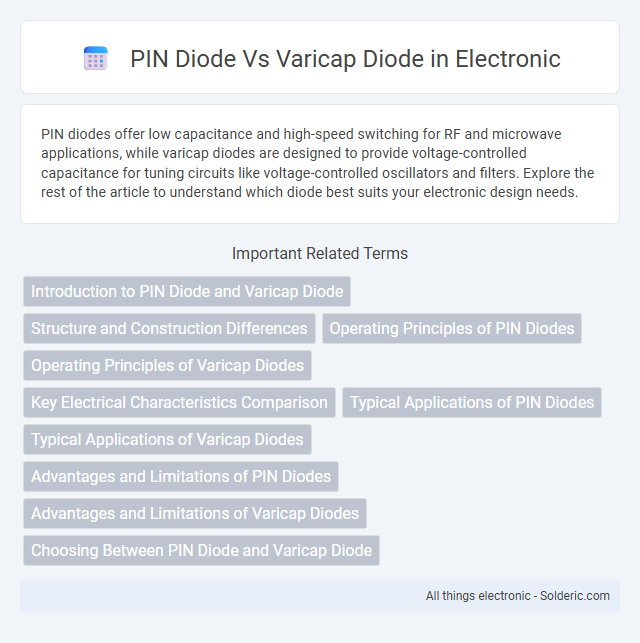PIN diodes offer low capacitance and high-speed switching for RF and microwave applications, while varicap diodes are designed to provide voltage-controlled capacitance for tuning circuits like voltage-controlled oscillators and filters. Explore the rest of the article to understand which diode best suits your electronic design needs.
Comparison Table
| Feature | PIN Diode | Varicap Diode |
|---|---|---|
| Function | RF switch and attenuator | Voltage-controlled variable capacitor |
| Structure | Intrinsic layer between P and N regions | Heavily doped P-N junction diode |
| Operation | Controlled by forward current | Controlled by reverse voltage |
| Application | Switching, RF modulation, attenuation | Tuning circuits, voltage-controlled oscillators |
| Response time | Fast switching speed | Voltage-dependent capacitance change |
| Capacitance Behavior | Low and stable | Variable, decreases with increase in reverse voltage |
| Biasing | Forward biased | Reverse biased |
| Frequency Range | Up to GHz range | Used in RF and microwave frequencies |
| Key Advantage | Handles high power with low distortion | Precise voltage-controlled tuning |
Introduction to PIN Diode and Varicap Diode
PIN diodes feature an intrinsic layer between the p-type and n-type regions, enabling high-frequency switching and RF attenuation with low distortion. Varicap diodes, also known as varactor diodes, use a voltage-dependent depletion region to vary capacitance, essential for tunable circuits such as voltage-controlled oscillators and filters. Both diodes serve distinct roles in RF and microwave applications, with PIN diodes optimized for signal control and varicap diodes specialized for frequency tuning.
Structure and Construction Differences
The PIN diode features a wide intrinsic layer sandwiched between the P-type and N-type regions, creating a unique structure ideal for high-frequency and RF applications due to its ability to act as a variable resistor. In contrast, the varicap diode, also known as a varactor, has a conventional P-N junction with a highly doped P or N region, designed specifically to vary its capacitance based on the applied reverse bias voltage. Understanding these structural differences helps you select the right diode type for tuning circuits, modulation, or switching applications.
Operating Principles of PIN Diodes
PIN diodes operate by injecting charge carriers into an intrinsic semiconductor region between p-type and n-type layers, allowing them to act as variable resistors at radio frequencies. Unlike varicap diodes, which rely on the voltage-dependent capacitance of a p-n junction to control frequency tuning, PIN diodes primarily modulate RF signals through changes in conductivity. Understanding this operating principle helps you select the appropriate diode for applications such as RF switches, attenuators, and phase shifters.
Operating Principles of Varicap Diodes
Varicap diodes operate by varying their capacitance in response to changes in reverse bias voltage, making them essential in tuning circuits such as voltage-controlled oscillators and frequency modulators. Unlike PIN diodes that act primarily as variable resistors at radio frequencies, varicap diodes function as voltage-dependent capacitors due to the depletion region width's modulation within the semiconductor junction. This unique property allows precise electronic control over resonant circuits without mechanical adjustments.
Key Electrical Characteristics Comparison
PIN diodes feature a wide intrinsic layer that allows for high-frequency switching with low capacitance and resistance, making them ideal for RF attenuation and switching applications. Varicap diodes, also known as varactor diodes, exhibit a voltage-dependent capacitance with minimal series resistance, enabling precise tuning in voltage-controlled oscillators and filters. The key electrical differences include PIN diodes' linear resistance variation under forward bias versus varicap diodes' variable capacitance controlled by reverse bias voltage.
Typical Applications of PIN Diodes
PIN diodes are typically used in RF switches, attenuators, and photodetectors due to their ability to handle high-frequency signals and power levels. Varicap diodes, on the other hand, are primarily employed in voltage-controlled oscillators, frequency modulators, and tunable filters because their capacitance varies with the applied voltage. Your choice between the two depends on whether the application requires signal modulation or frequency tuning functions.
Typical Applications of Varicap Diodes
Varicap diodes are widely used in voltage-controlled oscillators, frequency modulators, and RF filters due to their ability to provide voltage-dependent capacitance for tuning circuits. These diodes enable precise frequency control in communication devices, including TV tuners and phase-locked loops. Your electronic designs benefit from their efficient and reliable tuning capabilities in frequency agile systems.
Advantages and Limitations of PIN Diodes
PIN diodes offer high linearity and excellent RF switching capabilities, making them ideal for microwave and radio frequency applications. Their wide intrinsic layer provides low capacitance and high voltage handling, but they exhibit slower switching speeds compared to varicap diodes. PIN diodes have limitations in low-frequency tuning, where varicap diodes excel due to their variable capacitance controlled by voltage.
Advantages and Limitations of Varicap Diodes
Varicap diodes offer precise capacitance control through reverse voltage variation, making them ideal for tuning circuits in RF applications and voltage-controlled oscillators. Their advantages include low power consumption, fast response time, and high linearity in capacitance change, enabling efficient frequency modulation. However, varicap diodes have limitations such as limited capacitance range, lower power handling capability compared to PIN diodes, and sensitivity to temperature variations, which can affect circuit stability and performance.
Choosing Between PIN Diode and Varicap Diode
Choosing between a PIN diode and a varicap diode depends on the intended application in RF circuits; PIN diodes excel in high-frequency switching and attenuating signals due to their intrinsic layer that provides fast switching and low distortion. Varicap diodes are optimal for voltage-controlled tuning applications, such as voltage-controlled oscillators (VCOs) and frequency modulators, where capacitance changes with applied reverse voltage improve frequency agility. Selecting the appropriate diode involves analyzing circuit requirements for switching speed, linearity, and tuning range to ensure optimal performance.
PIN diode vs varicap diode Infographic

 solderic.com
solderic.com